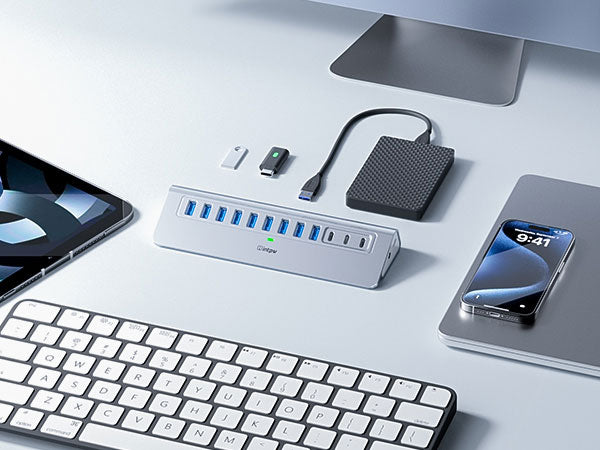
Thunderbolt 5: The Future of High-Speed Connectivity
, by USintpw, 6 min reading time

, by USintpw, 6 min reading time
Thunderbolt is a key part of modern computing, providing high-speed data transfer, connectivity, and peripheral support. Thunderbolt technology, introduced by Intel in 2011, has made a big impact on the tech industry.
The latest version, Thunderbolt 4, was a big improvement, offering faster speeds, better security, and more compatibility. The tech world is always changing. Now, everyone is watching Thunderbolt 5, a new technology that could make big changes.
The new Thunderbolt 5 is expected to be much faster, more powerful, and more connected than previous versions. But Thunderbolt 5 has more on the table than just faster data transfer rates. Let's look at what we know about this new standard and how it will change everything from home setups to workstations.
To fully appreciate the significance of Thunderbolt 5, it’s important to understand how we got here. Thunderbolt technology has evolved significantly over the past decade, and each iteration has introduced substantial advancements.
Thunderbolt 1, launched in 2011, was a game-changer in its own right. Thunderbolt 1 transferred large files at high speeds, making it a popular choice for users. It also supported data and video over the same cable, making it an efficient solution for connecting peripherals like external hard drives and monitors.
In 2013, Thunderbolt 2 doubled the transfer speed to 20Gbps. It used the same Mini DisplayPort connector but could transfer two 4K video streams at once. Thunderbolt 2 was fast but still had some limitations.
Thunderbolt 3, introduced in 2015, was a game-changer. It uses the USB-C connector, which works for data, power, and video. This change improved device compatibility and set a standard for future devices.
Thunderbolt 3 was a powerful 40Gbps connection for ultra-high-definition monitors, fast external storage, and GPUs. Thunderbolt 3's speed and versatility made it popular with consumers and professionals.
Thunderbolt 4, launched in 2020, refined Thunderbolt 3 without making drastic changes. While maintaining the same 40Gbps speed as its predecessor, Thunderbolt 4 focused on improving consistency and interoperability. It set higher standards for devices, ensuring greater security and better support for 4K displays and external storage. Thunderbolt 4 lets new laptops and desktops with USB-C ports work with other devices.
Thunderbolt 5 is poised to be the next giant leap. Thunderbolt 5 will offer faster speeds, better power delivery, and more robust support for displays, data, and peripherals.
Let's look at what Thunderbolt 5 can do. The official specs aren't out, but there are key improvements and features in the works.
The most anticipated feature of Thunderbolt 5 is its speed. Thunderbolt 5 is twice as fast as Thunderbolt 4, offering up to 80Gbps. This is a big jump in data transfer speeds, which will have a big impact on industries like video production, gaming, and cloud computing.
So, what does this mean for the average user? Thunderbolt 5 will enable ultra-fast file transfers, making it quick and efficient to move large files. This increase in bandwidth will let professionals work with larger datasets.
Thunderbolt 5 is likely to be based on the USB4 standard. USB4 speeds up data transfer and makes devices work better together. Intel will make sure that Thunderbolt 5 works with lots of different devices, from older Thunderbolt 3 ones to modern USB-C ones.
This is good for consumers because they can keep using their current devices. USB4 lets Thunderbolt 5 deliver more power while keeping data transfer efficient, which is great for laptops, mobiles, and other portable tech.
Power delivery is another area where Thunderbolt 5 will see significant improvements. Thunderbolt 4 supports up to 100W, but Thunderbolt 5 will go much further, potentially offering 240W or more. This new charger will let users charge laptops, tablets, and larger devices faster, without lots of extra cables.
The increased power capability of Thunderbolt 5 will also simplify device charging. A single Thunderbolt 5 cable can power all your peripherals, reducing clutter and improving the user experience.
Thunderbolt 5 will be faster and more powerful than previous versions of the technology.
As people want better and better displays, Thunderbolt 5 will support lots of 8K displays at once. This is great for videographers, creators, and gamers. Connect multiple 8K monitors with no latency and ultra-high-speed data transfer to create, edit, and view content at the highest quality.
Thunderbolt 5 will benefit professionals in fields like design, architecture, and finance, where lots of monitors are used.
Another area where Thunderbolt 5 will shine is in its ability to handle external storage devices. Faster data transfer speeds let users connect SSDs and RAID arrays to their computers, improving performance for data-heavy tasks.
This faster internet will let users stream video, work on big projects, and load games faster. For professionals who rely on external storage, Thunderbolt 5 will offer smoother, more efficient workflows.
Thunderbolt 5 will continue to support daisy-chaining, allowing users to connect multiple devices via a single Thunderbolt port. This is useful for people who need to connect multiple peripherals. The new bandwidth and power will let you connect and power multiple high-performance devices at once.
Thunderbolt 5 will likely have applications across several industries and use cases, from content creation to business and gaming.
Thunderbolt 5 is a game-changer for content creators. Transferring large video files, and connecting multiple monitors and peripherals at once will make creative workflows more efficient.
Thunderbolt 5 could help professionals working with VR and AR by providing the bandwidth to support high-quality, immersive environments.
Thunderbolt 5 gives gamers more speed and power. Thunderbolt 5 lets gamers use external GPUs to improve their gaming experience. Thunderbolt 5 is ideal for ultra-immersive gaming setups thanks to its support for multiple 4K or 8K monitors.
Businesses and enterprise users will benefit from Thunderbolt 5’s ability to support multiple peripherals and fast file transfers. Thunderbolt 5 helps you work faster and reduces downtime.
Thunderbolt 5 is shaping up to be a game-changer in the world of connectivity. Thunderbolt 5 will benefit consumers and businesses with its faster speeds, better power delivery, and higher-resolution displays. It will also lead to new content creation, gaming, and more.
Thunderbolt 5 will help us prepare for the future. Thunderbolt 5 is a connectivity solution for creative professionals, gamers, and anyone looking for a faster, more efficient computing experience. Look out for its release. It'll make a big impact on the tech world.

Subscribe to our emails